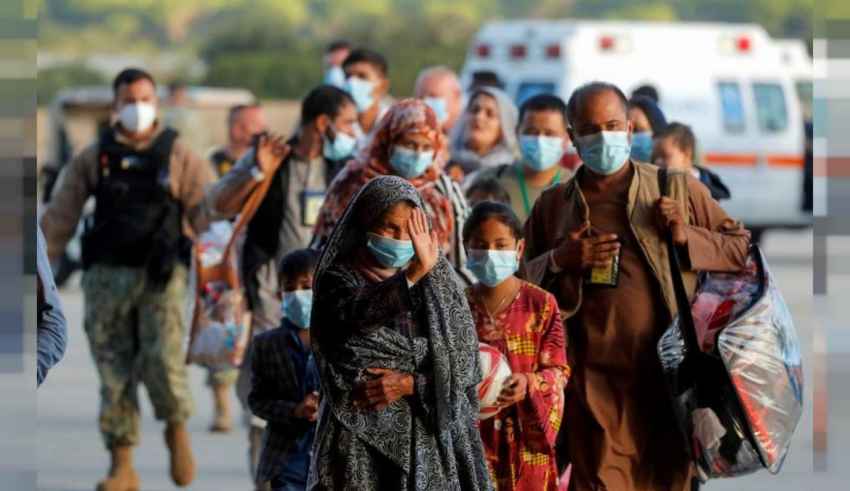
The collapse of the Afghan government and the Taliban’s military takeover jointly with the images of people at Kabul airport desperately trying to flee the country show the gravity of the problem that was mishandled by the international community including the EU. As evacuation efforts at Kabul International Airport wind down ahead of the Western troop withdrawal deadline of August 31, pressing questions remain about whether and where those fearful of Taliban rule or seeking to flee the country’s overlapping humanitarian crises will be able to find refuge. (Reidy, 2021)
Even before the Taliban’s military takeover, during the first eight months of the year, the effects of a severe drought, a falling economy, the COVID-19 pandemic, and growing violence were already pushing people to flee the country. In that context, the current crisis comes on top of the 2.2 million Afghan refugees already in neighbouring countries and 3.5 million Afghans internally displaced (UNHCR, 2020). Moreover, Afghan refugees have been the second largest group of asylum applicants in Europe since 2019, triggering the fear of European Member States to repeat the migratory crisis of 2015. It is estimated that since the beginning of 2021 over 550,000 Afghans have been internally displaced by conflict within the country, (OCHA, 2021), moreover, the UNHCR estimates that the number of displaced will rise, both internally and across borders following the events occurred in August 2021. Separate to the internal displacement mentioned above, a potential worst-case scenario envisages over 515,000 newly Afghan displaced refugees fleeing across the borders by the end of the year (UNHCR, 2021).
On August 2021, the United Nations Refugee Agency published a report concerning the UNHCR position on returns to Afghanistan, in which it called on UN members to allow Afghan civilians to access to their territories and to guarantee the principle of non-refoulement, according to international law. Particularly, the report states “In view of the volatility of the situation in Afghanistan, UNHCR does not consider it appropriate to deny international protection to Afghans and former habitual residents of Afghanistan on the basis of an internal flight or relocation alternative. UNHCR calls on States to suspend the forcible return of nationals and former habitual residents of Afghanistan, including those who have had their asylum claims rejected”.
Not only that, but it goes further by considering that it would not be appropriate to forcibly return Afghans to neighbour countries, namely Iran and Pakistan, as these countries “have for decades generously hosted the vast majority of the total global number of Afghan refugees” (UNHCR, 2021). Currently, Pakistan and Iran host 1.4 million and 780,000 Afghan refugees, respectively, representing an 80 percent of the registered Afghan refugees around the world. Both countries remain reticent and unwilling to host new refugees. Yet, whilst Pakistan has declared that it will not accept any more Afghan refugees, one border crossing has remained open to those seeking medical care and those with Pakistani resident papers. Additionally, Iran has set up temporary camps to house Afghans fleeing recent events, but has stated that any who enter would be deported when the situation improves.
The role of the European Union
Concerning the role of the European Union, its migratory and asylum policy has been characterized by a lack of coordination and solidarity. The new European Pact on Migration and Asylum, signed on the 23rd of September of 2020 (COM(2020) 609 final), aimed at overcoming the Dublin System’s inefficiencies, focuses on relocation or return sponsorship rather than on human rights and it does not provide for a mandatory and binding mechanism of relocation. On April 26 2021, the European Union signed a Joint Declaration on Migration Cooperation (JDMC) with Afghanistan, which replaced the previous Joint Way Forward (JWF) agreement and that facilitates the deportation of Afghans whose asylum applications have been rejected in the EU member states. The objective of the JDMC is “to establish a rapid, effective and manageable process for a smooth, dignified and orderly return of Afghan nationals who do not fulfill the conditions in force for entry to, presence in, or residence on the territory of the EU, and to facilitate their sustainable reintegration in Afghanistan in a spirit of cooperation”. This agreement has been criticized for undermining refugee rights because of the increasingly unwelcoming situation in the country of origin (Rahman, 2021) and because of its lack of transparency. In that sense, the JWF and the JDMC were not disclosed to the public and leaked by Statewatch. The leaked JWF, which was produced by the European Commission and the European External Action Service (EEAS), specifically mentioned Afghanistan’s reliance on foreign aid, suggesting that the Commission may use it as “potential leverage” in EU-Afghanistan migration cooperation. The Afghanistan’s former Minister of Refugee and Repatriation, Sayed Hussain Alemi Balkhi, criticized this: “In 2016, the EU tried to force Afghanistan to accept the return of its citizens whose asylum applications were rejected under the threat of losing the EU’s financial assistance.”
The EU national leaders’ statements have been dominated by a desire to keep Afghan asylum seekers out of Europe, reflecting the fear that the Taliban’s takeover of Afghanistan could spark a repeat of the 2015 migration crisis with Syrian refugees. However, the situation is not the same and much has been done since 2015 to protect the EU borders, including the signing of migration agreements with third countries, such as Turkey, the construction of border walls, and the widespread use of security force pushbacks at the EU’s external borders (Reidy, 2021). In addition, foreseeing the new arrivals of Afghan asylum seekers, Greece has constructed a 40-kilometer wall to protect its border with Turkey.
Following the recent events in Kabul, the Council of the European Union, on 31 August 2021, has published the “Statement on the situation in Afghanistan” after an extraordinary Council meeting to discuss developments in Afghanistan, specifically in relation to possible implications concerning international protection, migration and security (Council of the EU, 2021). The statement states that “the EU and its Member States stand determined to act jointly to prevent the recurrence of uncontrolled large-scale illegal migration movements faced in the past, by preparing a coordinated and orderly response”, however, the lack of a common response is to be seen when it provides for voluntary resettlement. Instead of a mandatory quota of asylum seekers to be taken by each Member State in function of their capacity, resettlement will be on a voluntary basis and financial aid will be provided to those countries facing a large number of Afghan refugees. Nonetheless, this call for solidarity is indeed a brief note in the overall text, which is primarily concerned with preventing uncontrolled, large-scale migration. The division within Europe on how to deal with the migratory crisis results in a lack of coordinated action of the EU that undermines the human right of seeking asylum and tends to have more impact to a block of EU countries.
While no concrete action is taken by the EU Member States, EU leaders encourage Afghanistan neighbour countries to host those Afghans fleeing the country by providing them with financial aid. In that respect, the statement of the Council of the EU remarks that “The EU will engage and strengthen its support to third countries, in particular the neighbouring and transit countries to reinforce their capacities to provide protection, dignified and safe reception conditions and sustainable livelihood for refugees and host communities”.
Suggestions:
The solution is not to be found in third country migratory agreements, after the lessons learned from the previous migratory crisis in 2015, the EU should not depend on Erdoğan’s willingness to not to breach the agreement as it constitutes a pressure instrument.
There is a need of a genuine European approach, in addition to providing financial and humanitarian assistance to Afghanistan and its neigbour countries, the European Union should act jointly to prevent inequalities between Member States and to effectively guarantee the right to seek asylum. The European Council should agree on a common set of asylum regulations to be enforced uniformly throughout the EU, including an obligatory quota system that distributes refugees among all member states. This would be the only way to speak about solidarity.
Bibliography:
Benedikter, R., and Pawel, I. (February, 2018), “Europe’s refugee and migrant crisis: Political responses to asymmetrical pressures”, at Politique Européenne, pp. 98-132.
Council of the European Union, (January, 2021), “Joint Declaration on Migration Cooperation between Afghanistan and the EU”. (5223/21 ADD 1).
Council of the European Union, (August, 2021), “Statement on the situation in Afghanistan”, available at: https://www.consilium.europa.eu/en/press/press-releases/2021/08/31/statement-on-the-situation-in-afghanistan/
Da Rosa, M. (July, 2021), “European Union Readmission Agreements: Deportation
as a Gateway to Displacement?”, E-international relations, available at: https://www.e-ir.info/2021/07/05/european-union-readmission-agreements-deportation-as-a-gateway-to-displacement/
Estevens, J. (October, 2018), “Migration crisis in the EU: developing a framework for analysis of national security and defence strategies”, Comparative Migration Studies.
European Council on Refugees and Exiles, (July, 2021), “Reception, detention and restriction of movement at EU external borders”, E-paper.
Kyriakopoulos, I. (April, 2019), “Europe’s Responses to the Migration Crisis: Implications for European Integration”, Institute of National Strategic Studies.
Loft, P. (August, 2021), “Afghanistan: Refugees and displaced people in 2021”, Research Briefing House of Commons Library.
Metcalfe-Hough, V. (October, 2015), “The migration crisis? Facts, challenges and possible solutions”, ODI briefing.
OCHA, (September, 2021), “Afghanistan: Weekly Humanitarian Update (23 – 29 August 2021)”, available at: https://reliefweb.int/report/afghanistan/afghanistan-weekly-humanitarian-update-23-29-august-2021.
Quie, M., and Hakimi, H. (November, 2020), “The EU and the politics of migration management in Afghanistan”, Chatham House.
Rahman Atal, M. (August, 2021), “The EU-Afghanistan Cooperation and a New Afghan Exodus”, Fluchtforschungsblog, available at: https://blog.fluchtforschung.net/the-eu-afghanistan-cooperation-and-a-new-afghan-exodus/
Rahman Atal, M. (May, 2021), “The Asymmetrical EU-Afghanistan Cooperation on Migration”, The Diplomat, available at: https://thediplomat.com/2021/05/asymmetrical-eu-afghanistan-cooperation-on-migration/
Reidy, E. (August, 2021), “The shrinking options for Afghans escaping Taliban rule”, The New Humanitarian.
Stanzel, A. (May, 2016), “Eternally displaced: Afghanistan’s refugee crisis and whit it means for Europe”, European Council on foreign relations.
Schultz, J., and Kaytaz, E., (August 2021) “Temporary protection as a durable solution for Afghan refugees in Europe?”, Chr. Michelsen Institute.
Scuto, F. (January, 2021), “Solidarity in the Common Asylum System and the Control of Illegal Immigration: A critique of the New EU Migration Pact”, Bridge, available at: https://bridgenetwork.eu/2021/01/14/solidarity-in-the-common-asylum-system-and-the-control-of-illegal-immigration-a-critique-of-the-new-eu-migration-pact/
UNHCR (August, 2021), “UNHCR position on returns to Afghanistan”, available at: https://www.refworld.org/pdfid/611a4c5c4.pdf.
Watkins, A., and Sharan, T. (2020), “Europe’s Engagement in Afghanistan Post-2021 Uncertainty, Pragmatism, and Continued Partnership”, Friedrich Ebert-Stiftung.
By Mahmoud Refaat: The European Institute for International Law and International Relations.














